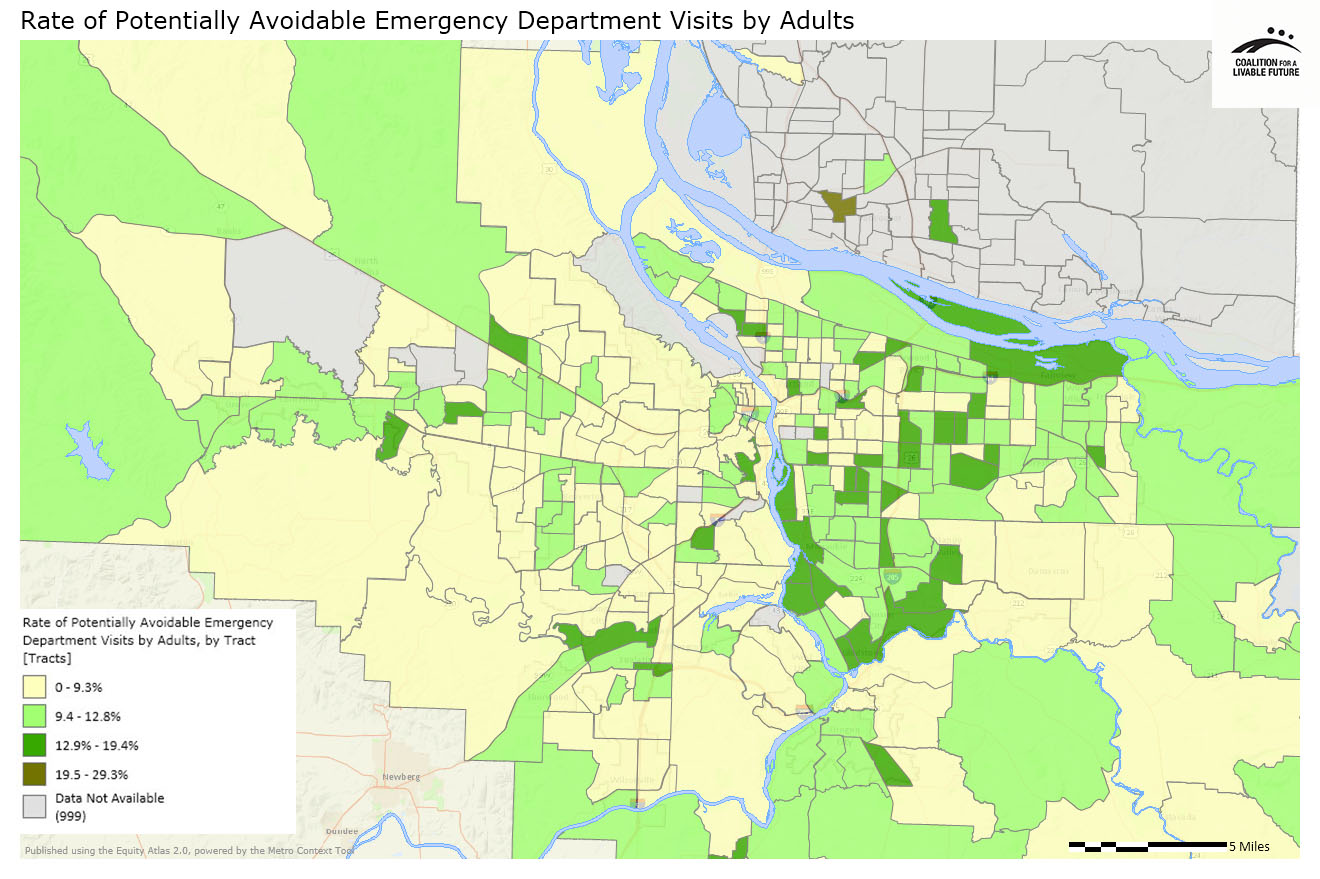
|
|
|
|
|
Access to preventive health care is an essential component of overall population health. Effective preventive health care can result in earlier diagnosis and treatment of acute health conditions, reduce the onset and severity of chronic disease, and improve overall health and well-being.
A key measurement of a population’s lack of access to preventive health care is the degree to which people rely on hospital emergency rooms for their medical care. Research has shown that many people seek emergency department care for health problems that are not emergencies, and that this pattern can be attributed at least in part to a lack of access to primary care services. Given the high cost of emergency department care, inappropriate emergency department use is a topic of concern for policy makers, public health experts, patients, and the health care industry.
The map of the Rate of Potentially Avoidable Emergency Department Visits documents the rate at which adults in each census tract used hospital emergency departments in 2011 for problems that could have been more appropriately managed by a primary care provider in an office or clinic setting. These data are mapped by patients’ home addresses aggregated by census tract.

Note: Although the Rate of Potentially Avoidable Emergency Department Visits by Adults map includes data for some Clark County census tracts, these data should be interpreted with caution. The data for this indicator come from health insurance claims records submitted to the Oregon Health Care Quality Corporation, which collects insurance claims data for health plans operating in Oregon. Some of the participating health plans submit claims data for members living in Clark County, but many do not. For this reason, the Clark County data are based on a limited population of Clark County residents and may not be representative of the entire population. The analysis of the patterns in the map will therefore focus only on the portions of the region located in Oregon.
According to the Rate of Potentially Avoidable Emergency Department Visits by Adults map, The census tracts with high rates of potentially avoidable emergency department visits (12.9% and above) are concentrated in Multnomah County and northern Clackamas County, including census tracts scattered throughout northeast and southeast Portland, and in parts of Gresham, Fairview, Troutdale, unincorporated Multnomah County, Happy Valley, Gladstone, and Milwaukie. Further out from the region’s core, several census tracts in Clackamas and Washington counties also have rates of 12.9% and above. In Clackamas County, these census tracts are located in Canby, the southern edge of Oregon City, and an unincorporated area on the far eastern edge of the county. In Washington County, these census tracts are located in and adjacent to Hillsboro and Tualatin.
The census tracts with the lowest rates of potentially avoidable emergency department visits (0-9.3%) are scattered throughout the region, particularly on the region’s west side and in several large census tracts in unincorporated areas of Clackamas County. It is notable that such a large portion of the census tracts in the region have a relatively low rate of potentially avoidable emergency department visits. However, it is important to remember that the data for this measure do not include uninsured patients. If uninsured patients were included, the rates might be higher in some census tracts across the region.
Further analysis is needed in order to better understand the geographic variations in the use of emergency departments for problems that could have likely been addressed through adequate preventive care. Many of the census tracts with the lowest rates of potentially avoidable emergency department use also have relatively low concentrations of primary care physicians, whereas many of the census tracts with higher rates of potentially avoidable emergency department use have high concentrations of primary care physicians. This suggests that proximity to preventive care is not a significant explanatory factor. Income may offer a partial explanation; the census tracts with the lowest rates of potentially avoidable emergency department visits tend to have above regional average median income. But this pattern isn’t uniformly the case, suggesting that income is probably only one of several factors underlying the patterns. The Atlas mapping tool can be used to investigate these patterns further by exploring potential correlations with other factors such as the age composition of each census tract and proximity to health care providers that accept Medicaid.
This map shows the percentage of emergency department visits by adults for problems that could have been more appropriately managed by a primary care provider in an office or clinic setting, by census tract. The data include patients 18 years or older at the time of the emergency department visit. These data are compiled from insurer claims data submitted to the Oregon Health Care Quality Corporation, including administrative claims (billing) data from seven commercial health plans, two Medicaid managed care plans and the Oregon Health Authority Division of Medical Assistance Programs (Medicaid). Data are reported only for those patients that were enrolled in a health plan that participates in the Oregon Health Care Quality Corporation’s measurement and reporting initiative or Medicaid fee-for-service on the day of the emergency department visit. This means that they do not represent all persons living within a census tract. Data were geocoded by patient address and aggregated into census tracts in order to maintain confidentiality.
The data for this indicator do not include data on uninsured patients, patients who pay for their own health care services, Medicare fee-for-service patients, or patients served by a plan or Medicaid provider that does not supply data to Oregon Health Care Quality Corporation.
Data Source: Oregon Health Care Quality Corporation 2011